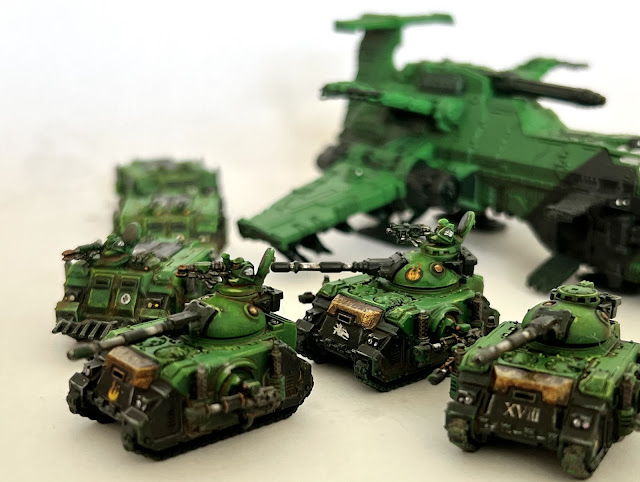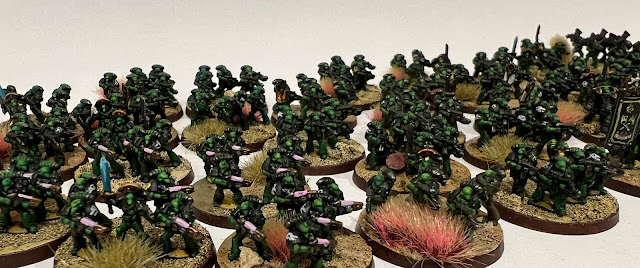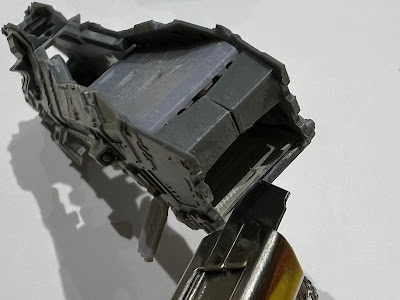+ Building the Legiones Imperialis Thunderhawk – with Battle Bling upgrades +
+ I received this Thunderhawk as a gift last weekend – a timely one, as I've got an Epic event coming up, organised by the chaps from the Maximal Fire Podcast [+noosphericexloadlink embedded+]. With a couple of weeks to go, I decided to superdetail it using the two upgrade kits from Battle Bling [+noosphericexloadlink embedded+]. +  |
| + Surprise assault – or speedy evacuation? Why choose when you can have both? + |
+++
+ What's in the box? Internal Detail kit +
+ Battle Bling supply two upgrade kits for the Thunderhawk. The first is the Internal Detail kit, which contains nine parts:
+ There are some pictures on the Battle Bling site to help you work out where things go, but since I was building it, I thought I'd document the process to help anyone else having a go – it's not especially complicated, but does benefit from some forward planning. +
+ The kit comes as shown above, nice and clean with the supports removed. It's worth giving them a quick once over to clean things up, but this will take only seconds per part. There's no need to wash the parts or anything. +
+ You will need +
- Sharp modelling knife
- Superglue
- Modelling files
- Polystyrene cement
- Modelling putty (optional)
If you want to hinge the front door, you'll also need:
- Sellotape
- Two small (~1mm) magnets
- Paperclip
- Clippers
_1 There are options for open or closed side doors: simply cut out the area shown and replace them on either side. You can use the existing detail to guide your cuts. I suggest that you dry fit the pieces repeatedly; trimming/filing away only what you need to to ensure a snug fit.
 |
| It's fairly obvious why you might want open doors for an interior detail kit, but why closed? The answer to that is that you will be able to see the sides of the interior through the front door, so even if you don't want open side doors, it's worth making the cut. |
_2 The open doors can go in the same place. Since you get a pair of each, you can have both open, both closed, or – as here – one of each. Open doors are probably more appropriate for landing dioramas, but I wanted to pop a spare infantryman in the open doorway for a little extra character.
_3 The large angled part is designed as the floor for the insides. Glue it on as shown before assembling anything. There's a little notch that slots in neatly to the floor, so it's easy to find the correct position.
If you want a functional ramp, avoid getting any glue close to the front (left side of the image) – see step 7 below.
Once glued, hold the piece until the superglue dries to ensure it is flat against the surface, then dry-fit the sides. You'll find you have to trim away the internal supporting struts shown in the centre of the picture. Don't worry, as the top part will fix any lost structural strength.
Also visible in this shot are the two sides. Note that I've popped out the dry-fitted side doors to avoid damaging them while I trimmed away the internal support.

_4 It's now time to start assembling things. Start by gluing the side doors and boltgun racks as shown. Once these are dry, add some polystyrene cement to the remaining plastic supporting struts and some superglue to the sides of the remaining large upgrade part. This is the roof, and it fits in as shown above.
Note that there's a bit of play for this top part – it will slide slightly forward or back in the space. I opted to slide it forward, but everything should still fit if you push it a little backwards, too.
_5 Carefully trim away the front ramp from the plastic part by repeatedly scoring a straight line. Don't use clippers or force with the knife, or you'll distort the plastic. Check that the replacement front ramp with internal detail fits.
_6 This is a good time to paint the insides of your Thunderhawk. For the purposes of this step-by-step, I've just given them a quick spray – but feel free to go to town.
_6 Glue the bottom part in place so you have a stable structure. Once dry, if you want a functional ramp, slide your knife blade between the plastic bottom part and the upgrade internal floor as shown.
_7 Use your knife and files to cut two small recesses in the top part – check that your small magnets fit inside.
Cut a 3 x 1cm (1¼ x ¾in) strip of sellotape, and carefully slide it into the gap, sticky side up. Leave about 1cm (¾in) showing.
Before moving on to the next step, paint the ramp to a finished state. I've added a little weathering to demonstrate (see below).
_8 Superglue the magnets in place. Note that the polarity doesn't strictly matter with this approach.
Use a round or rat-tail file to file a groove in the top of the ramp, and glue a length of paperclip into the groove. Align the ramp with the hinge at the bottom of the Thunderhawk and press the sellotape into place. It will remain visible, but as you can see, it's not obtrusive.
The ramp will now open and close. You can assemble the rest of the Thunderhawk per the box instructions.
+++
+ Finessing – or learning from the process +
+ As always, working through a process teaches you what to do better next time – so to benefit from my mistakes, here are some further thoughts. +
+ I only noticed after the whole thing was glued together that the open ramp reveals quite low headroom! I suggest that you trim down the front supporting area (the bit the magnets are in) before assembling the sides of the model. +
+ You might wish to use some greenstuff to help fill the holes for the magnets, too. +
+ If you'd prefer a sturdier or more professional quality for your hinge, you might replace the sellotape with higher-tack tape, or something purpose-made, like hinge tape [+noosphericexloadlink embdded+]. +
+++
+ What's in the box? External Detail kit +
+ Battle Bling's other offering for the Thunderhawk is the External Detail kit. No prizes for guessing what this eighteen-part upgrade is concerned with. +
+ Assembly for this is far more straightforward than the Internal Detail kit, so rather than a full step-by-step, I'll just give you some pictures and notes. +
+ The most obvious additions here are the turbolaser and tail. The turbolaser is a purely visual tweak that makes the design better match those of the Adeptus Titanicus laser weapons. This simply slots into place to replace the plastic version, using the same notches. +
+ The tail is my favourite bit. Not quite sure why GW lost the top of the tail in the redesign, but BB's upgrade replaces it. Again, this slots neatly into position, utilising the existing detailing to help you get the position spot on. +
 |
| + Fully assembled and ready to drop off – or pick up – Astartes. + |
+ Also visible on the left are the underwing lascannons and bombs. These are a visual upgrade (although perhaps they have rules in Aeronautica Imperialis?) and despite my love of heavy bolters, I quite like the gun barrels poking out from the wings. The underwing lascannons are two-parts each: the paired guns themselves, and the turret fittings (the round items in the picture at the start of this review). I assembled the turrets separately then glued them to the wings, but you could put the fitting in place before adding the guns in situ – just make sure you get them the right way round. +
+ The bombs fit into the gaps for the standard plastic missiles – and again, in Epic: Legions Imperialis terms, are just a nice visual difference, as the Thunderhawk doesn't have any in-game options. I opted to have a mix of missiles and bombs: the shattered Salamanders have to make do with what they can get hold of! +
+ Also included in the kit are two side sponsons. These are designed to fit in front of the side doors. I dry-fitted them and they fit very nicely – I simply opted for the standard heavy bolters because I like how they look. I'll save the lascannons for another day – perhaps another Thunderhawk or, as the size looks about right, to add some variety to a Land Raider squadron. +
+++
+ Notes +
+ The new Thunderhawk Gunship's a delight to build straight out of the box; and both sets of Battle Bling's excellent upgrades offer a lovely bit of icing on the cake. While not necessary, they are fun and add a lot of flavour to the standard kit. The Thunderhawk is a big model in Epic scale terms, and an obvious focal point. It's nice to be able to lavish some extra attention on it. +
+ While sturdy enough for gameplay, I'd suggest that the Internal Detail kit is ideal for superdetailed dioramas. There are even small holes in the (see step 4 of the Internal Upgrade instructions above), which might allow some talented electopriest to light up the insides... It's a great upgrade kit for anyone who wants to really get into the modelling aspect of the hobby. +
+ If you're on a budget, are more concerned about gaming, or aren't very confident in modelling, then I'd recommend the External Detail kit. It's a great introduction to third party upgrades, and is – for obvious reasons – much easier to spot at tabletop distances. +
+++
+ If Battle Bling are looking for future ideas, I'd love to see an upgrade set that replaces the plastic top, giving us the crew compartment and a top part with holes for the windscreens instead of solid plastic (some blister plastic could be used for the armourglass, as on my Blood Angels' Rhino). +
+ I'd also love to see the forward heavy bolter sponsons from the older design (pictured below). As with the crew compartment suggestion, this would give the kits more obvious visual differences from the stock kit. +
+ Size and dimensions of the LI/AI Thunderhawk +
+ Since posting up the review, a few requests have come in for the dimensions, so I got some pictcaptures. With my setup, there's some inevitable lens distortion, so I've added the length in the captions for clarity. Other than that, these pics are pretty straightforward. +
 |
| + Length from tip of nose to end of engine nacelle: 120mm + |
 |
| + Another shot of the overall length 120mm + |
 |
| + Width from wingtip to wingtip: 110mm + |
 |
| + Height from ground (including deployed landing gear) to top of tail: 48mm + |
++++ And finally +
+ There's a small subset of people – likely fans of Epic – who might have picked up the old resin Thunderhawk from Forgeworld when the first edition of Aeronautica Imperialis was out. Epic and AI 1st ed. were not a well-supported game at the time, so there aren't too many of these models out there. +
+ For this little niche audience, however, the following comparison pictures might be handy. As you'll see, the new plastic kit is larger – but not by the huge extent between the new and old Epic kits. If you've got the old resin Thunderhawk, you'll be pleased to hear that they'll look fine on the board – the differences in size perfectly attributable to different STC build patterns. +
+ Hope the review and pics are handy. +
+++


































































